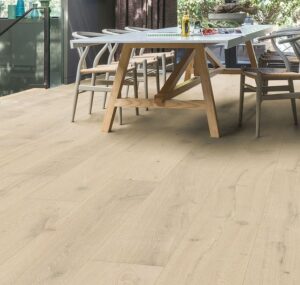In the quest for the ideal flooring solution for your home, you might have come across engineered hardwood. This type of flooring combines the natural beauty of hardwood with the durability and versatility of modern manufacturing techniques. Here, we delve into the pros and cons of engineered hardwood flooring.
The Nature of Engineered Hardwood Flooring
Engineered hardwood flooring is composed of multiple layers. The top layer is genuine hardwood, displaying the grain and colour you’d expect from any hardwood floor. Underneath this layer are several more layers of plywood or high-density fibreboard, arranged at different angles to each other for enhanced strength and stability.
Advantages of Engineered Hardwood Flooring
Engineered hardwood flooring offers a plethora of benefits, which make it an attractive option for many homeowners.
Stability and Durability
One of the main selling points of engineered hardwood flooring is its stability. Thanks to its multi-layer construction, this type of flooring is resistant to changes in temperature and humidity, reducing the likelihood of warping or distortion. Moreover, engineered hardwood is durable and can withstand significant wear and tear.
Easy Installation
Engineered hardwood flooring often comes in a variety of installation methods including click-lock, glue-down, or floating, making it suitable for DIY enthusiasts.
Versatility in Design
With a top layer that is genuine hardwood, engineered flooring provides the same natural beauty and luxurious feel as solid wood. Moreover, it comes in a wide range of finishes, from oak and maple to more exotic species like acacia and mahogany.
Sustainable Option
The manufacturing process of engineered hardwood flooring is more resource-efficient compared to solid hardwood. The use of plywood or high-density fibreboard for the majority of the product means fewer trees are required, making it a more sustainable option.
Disadvantages of Engineered Hardwood Flooring
While engineered hardwood flooring has many benefits, there are also certain drawbacks that need to be considered.
Limited Refinishing
Unlike solid hardwood, which can be sanded and refinished multiple times, engineered hardwood has a thinner top layer of real wood. This means it can only be refinished a limited number of times, if at all.
Cost
Though less expensive than solid hardwood, engineered hardwood flooring is typically more costly than other types of flooring like laminate or vinyl.
Sensitivity to Moisture
While engineered hardwood is more stable than solid wood, it is still susceptible to damage from excessive moisture. However, there are now options such as Quickstep Amato or Faro with a waterproof surface enabling installation in every area of the home including wet areas.
Conclusion
Engineered hardwood flooring offers a unique blend of beauty, durability, and versatility. Despite its drawbacks, its benefits make it an excellent choice for those seeking the aesthetics of real wood without some of the associated maintenance challenges. Ultimately, whether or not it’s the right choice for you will depend on your specific needs and circumstances. By understanding both the pros and cons of engineered hardwood flooring, you can make an informed decision about the best flooring option for your home.
May
19



Comments are closed.